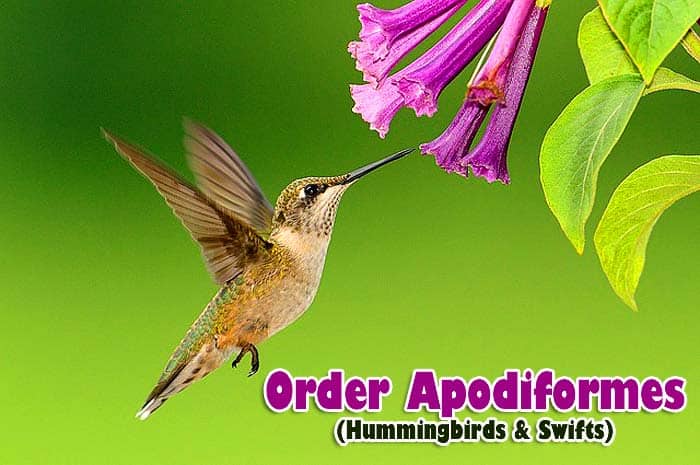
Order Apodiformes: According to the latest evaluations, both hummingbirds and swifts belong to order Apodiformes. There are 4 families in this order, namely Aegothelidae, Apodidae (Swifts), Hemiprocnidae, and Trochilidae (Hummingbirds).
As per the ITIS database, there are about 445 different types of birds classified under this order.
How To Pronounce Apodiformes?
Order Apodiformes Characteristics

These tiny and fast flying birds are easy to recognize based on the following traits:
- Most of the birds in this order are either small or very small.
- The Latin name of these birds translates as “footless” because most of the species in the order have small, underdeveloped feet, suitable mostly for perching, not walking.
- The legs of both hummingbirds and swifts have no scales, only skin.
- Apodiformes have unique wing structure with short arm bones long finger bones.
- Hummingbirds rely on hovering flight and have powerful muscles.
- Swifts rely more on the gliding flight and have slightly different wing structure.
- Many species in this order have a long, forked tail that is crucial for steering the flight.
- Hummingbirds have bright-colored plumage predominantly, while swifts are mostly colored black, grey or brown.
- Hummingbirds have a very short gut and have an extremely high number of erythrocytes that help bring oxygen to muscles.
- Hummingbirds depend on nectar as a food source. Their beaks are highly specialized for that purpose.
- Hummingbirds are known as American birds and are spread from South America to Alaska, except the most northern regions.
- On the other hand, swifts have different adaptations and diet.
- These birds rely on plankton in the air and are carnivorous.
- Unlike hummingbirds, swifts are spread around the whole planet except the Arctic and Antarctic.
- Hummingbirds are solitary birds, while swifts can form large colonies.
- Both hummingbirds and swifts have cup-like nests and lay around one or two small eggs.
- The young chicks hatch naked and blind and develop in their nests for a long time.
- Approximately a tenth of the species in this order is threatened and endangered in some way.
Suggested Reading: What do hummingbirds eat?
Apodiformes Birds / Types of Hummingbirds
Let us look at the variety of the species in Apodiformes order:
- Amethyst Woodstar, Calliphlox amethystina
- Andean Emerald, Agyrtria franciae
- Black Inca, Coeligena prunellei
- Copper-Tailed Hummingbird, Saucerottia cupreicauda
- Green Mango, Anthracothorax viridis
- Magnificent hummingbird, Eugenes fulgens
- Jamaican Mango, Anthracothorax mango
- Puerto Rican Emerald, Riccordia maugaeus
- Spot-fronted swift, Cypseloides cherriei
- Sooty swift, Cypseloides fumigatus
- Rotschild’s swift, Cypseloides rothschildi
- Indian swiftlet, Aerodramus unicolor
Cite This Page
APA7MLA8Chicago
BioExplorer.net. (2024, April 26). Order Apodiformes / Hummingbirds and Swifts. Bio Explorer. https://www.bioexplorer.net/order-apodiformes/.
BioExplorer.net. "Order Apodiformes / Hummingbirds and Swifts" Bio Explorer, 26 April 2024, https://www.bioexplorer.net/order-apodiformes/.
BioExplorer.net. "Order Apodiformes / Hummingbirds and Swifts" Bio Explorer, April 26 2024. https://www.bioexplorer.net/order-apodiformes/.

























